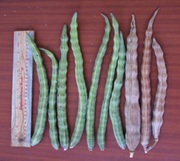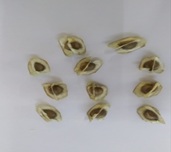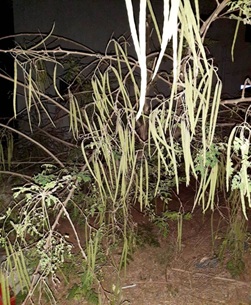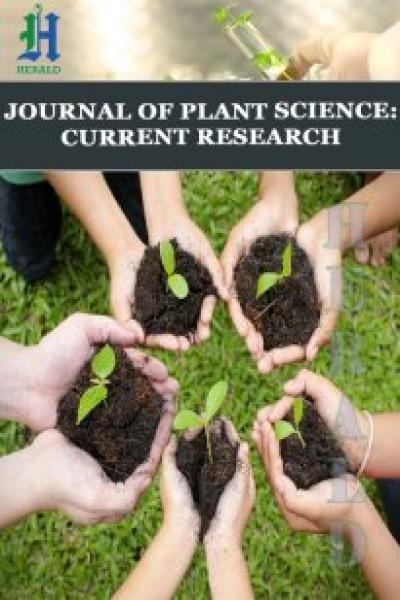
Collection and Conservation of Local Types of Moringa (Moringa oleifera (L.) Trees for Good Sources of Traditional Vegetable
*Corresponding Author(s):
Pandiyan MAgricultural College And Research Institute, Tamil Nadu Agricultural University, Vazhavachanur, Thiruvannamalai, Tamil Nadu, India
Tel:+ 91 9865173633,
Email:mpandiyan8@yahoo.co.in
Abstract
With an objective to conserve the best local types for future generation and purpose of these trees protected from extinction due to national high ways road expansion by the government and local bodies. The collection was made in and around our college about 15 km radius found small tree uniformly good Moringa types are cultivating as kitchen garden tree in front and backside of the home where tribal areas of Tiruvannamalai district. Continues concentration of tagged trees for three years study related to growth habits, fruiting capacity, taste of fruits and market value of fruits, the green pod yield assessment was recorded from the marked trees. Among the tagged trees over three years study, the Vahavachanur 1. Perunduraipattu3, Michealpuram 5, Moongilduraipattu 1 and Vanapuram 3 trees qualities are better for rganoleptically culinary vegetable purpose and also Vzhavachanur1 tree found offseason bearing than other areas trees inclusing selected trees. The off season bearing trees were marked among tagged trees. The organoleptic test was also carried out in the selected trees and best trees were selected and planted in the college premises for follow up study. The culture VVNR-019-001 local is identified for best performing genotype. It is a selection from the Vazhavachanur village of Thiruvannamalai, District. This Moringa is perennial, short type, cluster bearing, annual type and drought resistant with the high yield of 600-800 fruits per year and it is most suitable for culinary , vegetable soup, green leafy, powder making and also suitable for cattle feed . It is drought resistant, heavy fruit-bearing, pest and disease resistant types with retaining all the leaf and fruit qualities.
Keywords
Drought tolerant; Moringa annual type; More number of fruits; Off season bearing; Good quality; Short fruit type
INTRODUCTION
Moringa (Moringa oleifera (L.)) belonging to the family moringaceae is a softwood tree, native of India, occurring wild in the sub-Himalayan regions of Northern India and now grown worldwide in the tropics and sub-tropics. The cultivation of Moringa in India occurs mainly in the southern states of Tamil Nadu, Karnataka, Kerala, and Andhra Pradesh. Principally perennial types have been known for cultivation for a very long time. However, perennial types are best with many advantages to give year around yield. In India it is grown all over the subcontinent for its tender
pods and also for its leaves and flowers. The pod of Moringa is a very popular vegetable in South Indian cuisine and valued for their distinctly inviting flavor. The tree has vitamins, minerals and medicinal values. Moringa attracted very strong place among Tamil family through Tamil cinema. Generally the moringa tree is used in Sidha Medicine. Mostly consumed as leafy vegetable including pods for culinary purpose. It is having medicinal value. It has lot of nutrients like carbohydrate, fibre, protein , fat and salt apart from these VitaminA, Vitamin E, Vitamin K, VitaminC, Vitamin B1 thiamin,B12, Vitamin B6 and Ribofavin. Minerals like potassium, calcium, magnesium, Iron and Zinc are present in the Moringa plants. Vitamin C or ascorbic acid is an essential water soluble vitamin present in moringa support to cure that has been found to be low in IBD patients, The wound healing effects of vitamin C are particularly important source available in Moringa. During road expansion traditional types of Moringa has been removed by the road workers , to review same genotypes for future human use the conservation is necessarily has been done in nearby Agricultural College and Research institute.
MATERIALS AND METHODS
In locally available traditional types of 150 trees were marked in 10 villages namely Vazhavachanur, moongilthuraipattu, Michealpuram, Kottaiyur, Sadhakuppam, Vanapuram, Perunduraipattu, Anthoniyarpuram, Vadaponparappi, and Thandrampattu and 15 genotypes were selected and marked given number to each tree from 1 to 15 bearing their respective village names. The observations were taken namely perennial type, long bearing period of Januray to April and May, height with primary branches, No. of secondary branches, Branching pattern, open crown of drooping, fragile branches Leaves colour, leaves type compound, with tripinnate, length of leaves, number of leaf segments, no of leaf lets, Length of leaf segment, leaflet size, leaf shape, No. of flower per inflorescence. Types of flowers monoceous and bisexual, petals colour. Flowers size and length, flower growth habit, Flower colour with base and anthesis time. Number of fruits per cluster, Pods types, colour of fruits, length of fruits. Pod taperness. Pod weight, Pod girth, Pod splitting nature and off season characters were carried out for past three years. Finally, based on the visual observation eight trees namely Vahavachanur 1,3,8. Perunduraipattu3,5, Michealpuram 5, Moongilthuraipattu 1 and Vanapuram 3 were selected from five villages, the number has given VVNR-019-001, VVNR-019-002, VVNR-019-003, VVNR-019-004, VVNR-019-005, VVNR-019-006, VVNR-019-007 and VVNR-019-008 according to the yield performance of trees for the past three years. Purity also retested in our college. Matured branches were removed from the selected trees and planted at isolated area of our college. The spacing for trees between 5 meter gaps around trees.
RESULT AND DISCUSSION
All eight genotypes namely VVNR-019-001, VVNR-019-002, VVNR-019-003,VVNR-019-004, VVNR-019-005, VVNR-019-006, VVNR-019-007 and VVNR-019-008 showing same expressions for parental characters. There is no variation. Among eight genotypes, one genotype VVNR-019-001 somewhat better for early regeneration flowering and fruiting. The observation was made in VVNR-019-001. The best genotype namely VVNR-019-001 is botanically scored as follows Moringa oleifera (L.) selection was starts with open pollination in Thiruvannamalai District. It is perennial type and has long bearing period of Januray to April and May. It can grow upto 4-5 m height with primary branches is 3-5 Nos. No. of secondary branches are 15. Nos. with branch length of 2m. The tree has an open crown of drooping, fragile branches . Branching pattern is upright. Leaves are pale green, compound, with tripinnate, 35- 65 cm long, number of leaf segments are 3 - 5 with 150 to 350 leaf lets. Length of leaf segment is 10.2 - 14.5 cm and leaf is 2.5 cm long, 2.0 cm wide, lateral ones somewhat elliptic, terminal one obovate and slightly larger than the lateral ones. No. of flower per inflorescence cluster is 140. The flowers are fragrant and bisexual, surrounded by five unequal, thinly veined, yellowish-white petals. The flowers are about 1.0-1.5 cm long and 2.0 cm broad. They grow on slender, hairy stalks in spreading or drooping later flower clusters which have a length of 25 cm. Flower type is irregular and colour is white with greenish base and anthesis time is 6.00 am to 12.00 pm. Number of fruits per cluster is 5 -10. Pods pendulous ( Figure 1), brown, triangular, splitting lengthwise into 3 parts when dry, 42 cm long, 1.8 cm wide, containing about 18 seeds embedded in the pith. Pod tapering at both ends, 9 ribbed seeds dark brown with 3 papery wings (Figure 2). Vegetable pod colour is green. Pod weight of 100 g with 4 cm girth with the yield of 500-800 fruits per year (Figure 3).
 Figure 1: Moringa VVNR-019-001 greenpods and matured pods.
Figure 1: Moringa VVNR-019-001 greenpods and matured pods.
 Figure 2: Moringa VVNR-019-001 matured seeds.
Figure 2: Moringa VVNR-019-001 matured seeds.
 Figure 3: Moringa VVNR-019-001 single tree bearing more number of pods.
Figure 3: Moringa VVNR-019-001 single tree bearing more number of pods.
Trees can be maintained upto 10 years. The above characters almost elaborately explained as M. oleifera is a fast-growing, deciduous tree that can reach a height of 10-12 m and trunk diameter of 45 cm. The bark has a whitish grey colour and is surrounded by thick cork. Young shoots have purplish or greenish white, hairy bark. The tree has an open crown of drooping, fragile branches and the leaves build up feathery foliage of tripinnate leaves. The flowers are fragrant and hermaphroditic, surrounded by five unequal, thinly veined, yellowish white petals. The flowers are about 1.0-1.5 cm long and 2.0 cm broad. They grow on slender, hairy stalks in spreading or drooping flower clusters which have a length of 10-25 cm. Flowering begins within the first six months after planting. In seasonally cool regions, flowering only occurs once a year between April and June. In more constant seasonal temperatures and with constant rainfall, flowering can happen twice or even all year round. The fruit is a hanging, three sided brown capsule of 20-45 cm size which holds dark brown, globular seeds with a diameter around 1 cm. The seeds have three whitish papery wings and are dispersed by wind and water. In cultivation, it is often cut back annually to 1-2 m and allowed to re grow so the pods and leaves remain within arm's reach in wikipedia.org/wiki/Moringa oleifera and also reported revealed the same results by [1-5]. Plant parts are Leaves, Flowers, Seeds, Pods, Roots , Bark, Gum, Oil from seeds in drumstick report have been agreed by [6].
The above characters were agreed with the many Moringa workers [7-9] reported moringa is an nutrient to the human [4,10] reported Moringa as vegetable crop. Ramachandran et al., "Drumstick (Moringa oleifera) is a multipurpose Indian vegetable [11]. Rashid et al., revealed Moringa oleifera oil a possible source of biodiesel [12]. Sogbo reported as Moringa leaf farming is revenue to the growers [13,14]. Moringa leaf having Antioxidant activity and total phenol content.
CONCLUSION
The traditional local types of Moringa genotypes were evaluated for many characters and protected and conserved extinction Moringa trees at Government Agricultural College for future generation use. Off season bearing with high yielding types were conserved.
REFERENCES
- Olson ME, Carlquist S (2001) Stem and root anatomical correlations with life form diversity, ecology, and systematics in Moringa (Moringaceae). Botanical Journal of the Linnean Society 135: 315-348.
- Olson ME (2010) Moringaceae Martinov; Drumstick Tree Family; In: Flora of North America, North of Mexico, Volume 7: Magnoliophyta: Dilleniidae, Part 2. Oxford University Press. Pg no. 168.
- Iqbal S, Bhanger MI (2006) Effect of season and production location on antioxidant activity of Moringa oleifera leaves grown in Pakistan. Journal of Food Composition and Analysis 19: 544-551.
- Grubben G (2004) Grubben, G. J. H. (ed.). Vegetables. 2 (Plant resources of tropical Africa ed.). Pg no. 394. ISBN978-9057821479.
- Booth FEM, Wickens GE (1988) Non-timber Uses of Selected Arid Zone Trees and Shrubs in Africa, Pg no.98, FAO, Rome
- Palada MC (1996) Moringa (Moringa oleifera): A versatile tree crop with horticultural potential in the subtropical United States. Hort Science 31, 794-797.
- Gopalan C, Rama Sastri BV, Balasubramanian SC (1971) Nutritive Value of Indian Foods. Hyderabad:National Institute of Nutrition, Indian Council of Medical Research. Pg no. 66, 78.
- Kumar HD (1 January 2004) Management of Nutritional and Health Needs of Malnourished and Vegetarian People in India". In Cooper, Edwin L.; Yamaguchi, Nobuo (eds.). Complementary and Alternative Approaches to Biomedicine. Advances in Experimental Medicine and Biology. 546. Springer US. pp. 311-321.
- Mahajan SG, Mali RG, Mehta AA (2007) Protective effect of ethanolic extract of seeds of Moringa oleifera against inflammation associated with development of arthritis in rats. J Immunotoxicol 4: 39-47.
- Peter KV (2008) Underutilized and Underexploited Horticultural Crops:, Volume 4. New India Publishing. p. 112.
- Ramachandran C, Peter KV, Gopalakrishnan PK (1980) Drumstick (Moringa oleifera): A multipurpose Indian vegetable. Economic Botany 34: 276-283.
- Rashid U, Anwar F, Moser BR, Gerhard K (2008) Moringa oleifera oil: A possible source of biodiesel". Bioresource Technology 99: 8175-8179.
- Sogbo KA (2006) Moringa Leaf Farming Systems: Conditions for Profitability and Sustainability.
- Sreelatha S, Padma PR (2009) Antioxidant activity and total phenolic content of Moringa oleifera leaves in two stages of maturity". Plant Foods for Human Nutrition. 64: 303-311.
Citation: Pandiyan M, Sivakumar C, Radhakrishnan V, Krishnaveni A, Paramasivam V, et al. (2020) Collection and Conservation of Local Types of Moringa (Moringa oleifera (L.) Trees for Good Sources of Traditional Vegetable. J Plant Sci Curr Res 4: 010
Copyright: © 2020 Pandiyan M, et al. This is an open-access article distributed under the terms of the Creative Commons Attribution License, which permits unrestricted use, distribution, and reproduction in any medium, provided the original author and source are credited.

